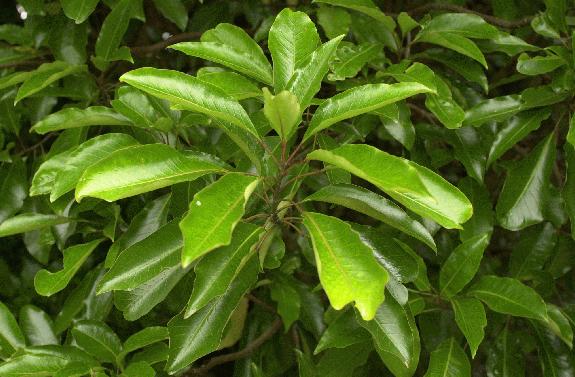raukawa
1. (noun) raukawa, Raukaua edgerleyi - a tree with glossy, deep green leaves, a yellowish prominent midvein and paler olive-green underneath. Used traditionally for scented oils.
(Te Māhuri Textbook (Ed. 2): 119;)
Ko te tohu a Tūrongo ko te pai o te kakara o te hinu raukawa, pania ai e Māhinārangi ki a ia, ka haere ai ki te tūtaki ki a Tūrongo (TWK 3:21). / The distinguishing feature for Tūrongo was the pleasant fragrance of the raukawa oil, which Māhinārangi spread on herself when she went to meet with Tūrongo.
Synonyms: koare, kōareare, houmangōroa
2. (noun) raukawa, Raukaua edgerleyi - a tree with glossy, deep green leaves, a yellowish prominent midvein and paler olive-green underneath. Used traditionally for scented oils.
See also raukawa
Synonyms: koare, raukawa, houmangōroa
koare
1. (noun) raukawa, Raukaua edgerleyi - a tree with glossy, deep green leaves, a yellowish prominent midvein and paler olive-green underneath. Used traditionally for scented oils.
See also raukawa
Synonyms: kōareare, raukawa, houmangōroa
houmangōroa
1. (noun) raukawa, Raukaua simplex - shrub to 8 m tall with sharply serrate leaves in the adult form. Flowers pale green, fruit purplish black. Found in most montane and subalpine forest in Aotearoa/New Zealand. Only called this in adult form.
Synonyms: haumakāroa, haumangōroa, haumakōroa, koare, kōareare, raukawa
Paki o Matariki, Te
1. 'The widespread calm of Pleiades - the name of the coat of arms of the Kīngitanga which was designed by two Tainui tohunga, Tīwai Parāone of the Hauraki tribes and Te Aokatoa of the Waikato and Raukawa tribes. The work was approved in the time of King Tāwhiao, the second Māori king. The double spiral in the centre represents the creation with the series of strokes between the double lines marking off the various stages in the creation of the world. The figure on the right represents te atuatanga (spirituality) and the one on the left aituā (misfortune). The cross with the heart design represents Christianity while the seven stars represent Matariki, the Pleiades. The nīkau tree and harakeke plant on the right represent housing and clothing of the ancient Māori. The mamaku, an edible tree fern, and para, the tuber of which was used as food, are symbolic of the food of the Māori.
(Te Kōhure Textbook (Ed. 2): 1;)
Hei tohu i te mana me te awe hoki o Mere Rikiriki, i tāpaetia atu ai e Kīngi Tāwhiao he haki māna, e mau nei te īngoa ko 'E Te Iwi Kia Ora'; kātahi te taonga matahīapo ko tēnei; ko ōna tino tohu ko Te Paki o Matariki (TTR 1996:171). / Mere Rikiriki's influence and mana is demonstrated by King Tawhiao's presentation to her of the flag with the name 'E Te Iwi Kia Ora'; this was a prized treasure with significant markings known as Te Paki o Matariki.




